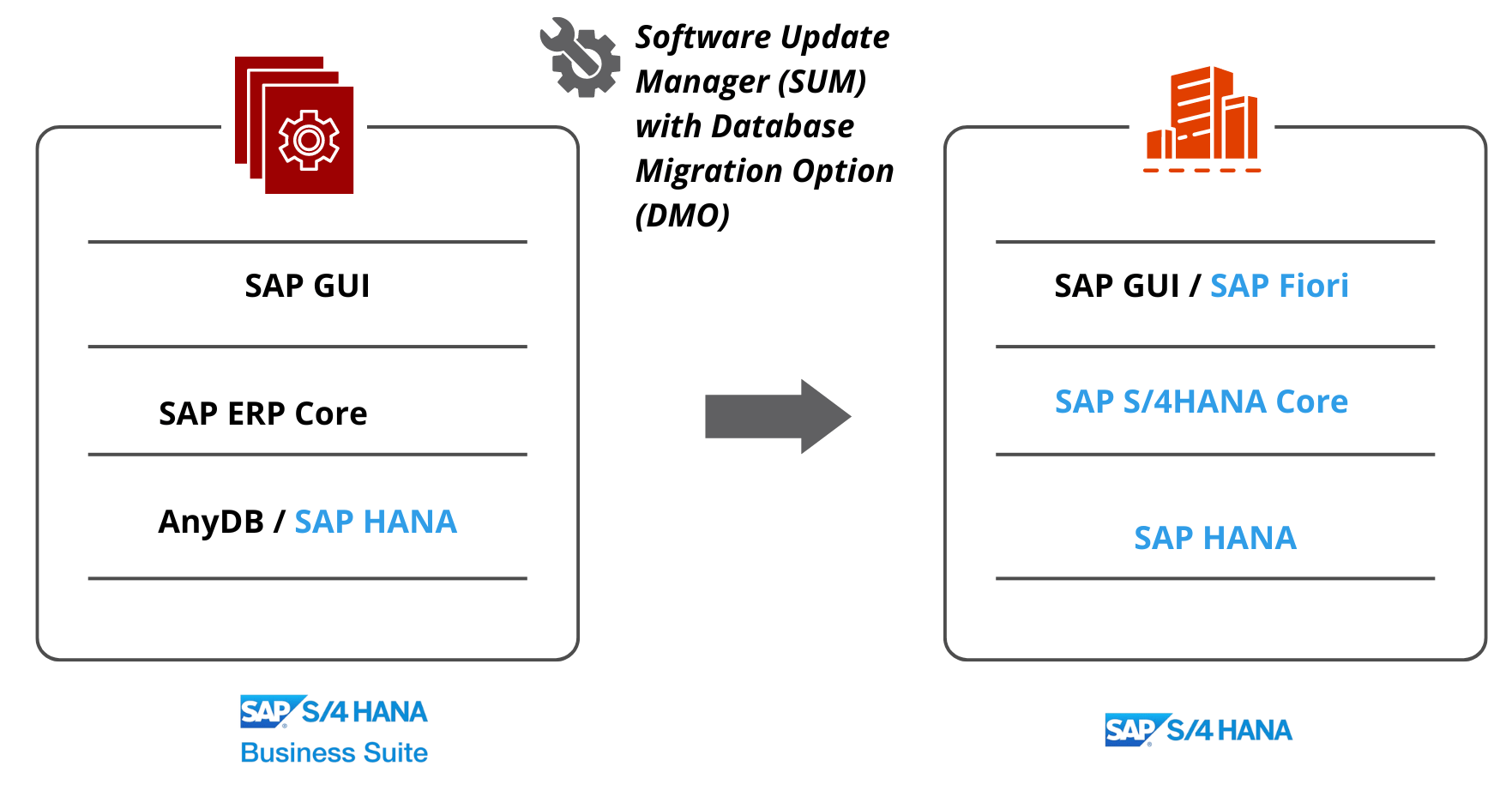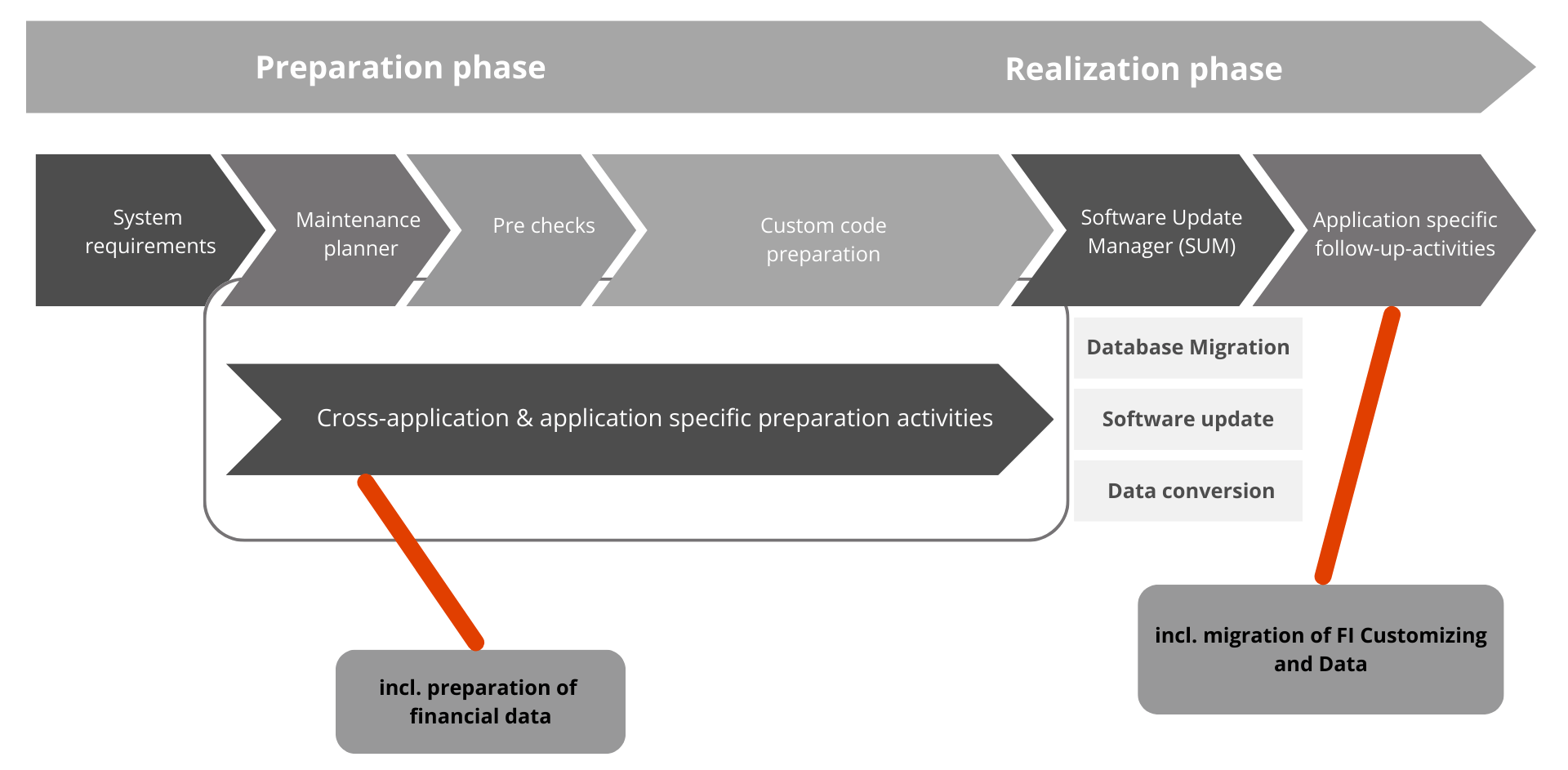What are the Different SAP S/4HANA Adoption Scenarios?

SAP introduced SAP S/4HANA in 2015. Since then, organizations have been actively adopting SAP S/4HANA, the post-modern SAP ERP, to guide them on their path to digital transformation. This blog explains the available SAP S/4HANA adoption scenarios including their technical tooling so that organizations planning to migrate to SAP S/4HANA can make the best individually suited decision for their system landscape.
Replacing a non-SAP Landscape
Replacing any non-SAP / 3rd-party System with SAP S/4HANA always means a new SAP S/4HANA implementation. In such a scenario, the only choice to make is about the deployment option. The deployment maybe either be on-premise or on the cloud (public or private option is possible).
One of our clients in Oman chose to adopt an SAP S/4HANA new implementation. View our case study to learn more about the project.
Replacing an SAP ECC ERP Landscape
Organizations must understand that SAP S/4HANA is not a successor release of SAP Business Suite ERP system. SAP S/4HANA is a new product line. This means that there are some incompatible changes between an SAP Business Suite ERP System and an SAP S/4HANA system.
- SAP S/4HANA is based exclusively on SAP’s in-memory database SAP HANA
- It has a new application architecture
- It also has a new and simplified application data model
- Besides application functionality contained in compatibility packs, many SAP S/4HANA applications have been re-designed
- You can now use a new UI technology, SAP Fiori.
- You can choose between two deployment models: on-premise and cloud (both private and public cloud versions are available)
If you intend to replace your existing SAP Business Suite system/system landscape with SAP S/4HANA, you should know that SAP S/4HANA is not a release update. This gives you the chance to consider the extent to which you want to innovate and keep business processes and applications which are still good enough.
SAP S/4HANA Adoption Scenarios
There are three ways by which you can approach the transition of an existing SAP ECC ERP landscape to SAP S/4HANA.
1. SAP S/4HANA Adoption with a System Conversion
An SAP S/4HANA system conversion process involves a tool-based, in-place technical conversion from SAP ECC to SAP S/4HANA using SUM. Downtime minimizing options are available using this approach. This process changes the existing system into an SAP S/4HANA system. KTern – the all-in-one product to automate and manage S/4HANA conversions helps to complete the transition with the right effort, project timeline, and cost.

- It facilitates a database migration from any classical DB to SAP HANA
- Helps to migrate the SAP ERP data model into the SAP S/4HANA data model with all invented data model simplifications and data volume reductions
- It replaces old SAP ERP Application Code with SAP S/4HANA Application Code
- It does not force you to migrate classical SAP GUI UIs to Fiori Apps! You can do this selectively in a later step.
The following picture illustrates the technical system conversion process from the planning over preparation, execution and post-processing steps:

Reasons to choose an SAP S/4HANA system conversion
You should choose this option if your main goal is to bring your current business processes to the new platform, and/or if you want to keep your investment in custom code.
This option also helps to mitigate the risk and investment of a big bang conversion project. This is achieved by reducing the scope of the transition to a pure technical conversion project. You can then plan to adopt new innovations at your speed later in a phased approach.
A high-tech manufacturer chose to adopt this approach, and it helped to effectively reduce their data footprint by 50%. You can read more about the project by accessing our whitepaper.
2. SAP S/4HANA Adoption with a New Implementation
This scenario (also called as “greenfield” approach) describes a fresh, new installation of a SAP S/4HANA system (either on-premise or cloud-based).
SAP S/4HANA (on-premise or cloud-based) is installed using the software provisioning manager. The initial data load from the source system is completed with the SAP S/4HANA migration cockpit or with SAP data services (with best practice migration content). The old landscape can then be retired.
The project duration will depend on:
- Number of required data migration objects (Material, Business Partner, etc.)
- Volume and complexity per data migration object
Reasons to choose an SAP S/4HANA new implementation
This SAP S/4HANA adoption method is perfect if re-engineering and process simplification based on latest innovations are your primary focus. It is especially well suited for organizations planning to migrate
- A non-SAP / 3rd-part legacy system
- An SAP System which
- Is of an older release
- Highly customized/modified
- Does not meet the system requirements for a technical system conversion
The benefits of choosing this approach are
- Reengineering and process simplification based on pre-configured business processes
- Predefined migration objects & best practices to avoid intensive migration logic programming
- A rapid adoption of new innovations in a standardized manner
3. SAP S/4HANA Adoption with an SAP Landscape Transformation
An SAP Landscape transformation is a value-driven, selective data migration to the new SAP S/4HANA platform. The focus is not on a whole system migration, but on picking & choosing entities which you want to carve out and move on to the SAP S/4HANA platform. Therefore there are several sub-scenarios available:
- Consolidation of current SAP Business Suite landscape (multiple systems, or selective clients of multiple systems) into one global SAP S/4HANA system
- Selective data migration based on legal entities, such a clients or company codes
- Implementation of SAP Central Finance Scenario including real-time reposting of financial transactions into Central Finance instance (synchronization of systems)
In principle, an SAP Landscape Transformation is not an either-or-option in comparison to the SAP S/4HANA system conversion and SAP S/4HANA new Implementation scenarios. As it is a data migration option, it requires a target system available into which the data can be migrated.
The target system can be realized with a fresh system install (SAP S/4HANA new implementation scenario with/without an initial data load). Or, as in the case of a system consolidation effort, the target system is also realizable with an SAP S/4HANA system conversion of a suitable SAP ERP system. Having the target system in place, a Landscape Transformation migrates (additional) data into the SAP S/4HANA systems independent from their origin or purpose.
The various available Landscape transformation Scenarios can migrate data:
- Into newly implemented SAP S/4HANA target systems
- Into systems created via a system conversion procedure
- Before or after they are handed over to operations
- To complement other SAP S/4HANA transition options
The SAP landscape transformation scenario currently requires a service or consulting engagement with SAP. There is no toolset with documentation available to configure, test and execute your own, individual data migration to SAP S/4HANA. The currently available tools and technology are only available via SAP Value Assurance Services or Consulting service Engagements.
A data migration platform product will be released eventually, which will cover selected data transformation scenarios to be executed by customers and partners without SAP Service engagement.
Reasons to Select an SAP Landscape Transformation
- Selective data transformation allows a phased approach for SAP S/4HANA
- Focus on SAP S/4HANA migration phases on parts of the business with highest ROI and lowest TCO
- Move gradually to SAP S/4HANA innovations while running current business processes
- System and landscape consolidation with harmonized/ simplified processes and unified master data lead to lower cost of operations
- Achieve harmonized business processes and shared master data through consolidation
- Carve out entities of the company to SAP S/4HANA and leverage process simplification
You can read more about the project on SAP Landscape Transformation by accessing our whitepaper.
If you are looking to adopt SAP S/4HANA and want to realize the ideal path for SAP S/4HANA Adoption for your organization, contact us by clicking here. We can carry out an in-depth SAP S/4HANA assessment using our very own product to ensure you take the right path to SAP S/4HANA.
FAQ’s
1. What are the main SAP S/4HANA adoption scenarios?
The three primary adoption scenarios are System Conversion, New Implementation (Greenfield), and SAP Landscape Transformation.
2. What is the difference between system conversion and new implementation in SAP S/4HANA?
System Conversion upgrades your existing SAP ECC to SAP S/4HANA, while New Implementation involves setting up a completely fresh SAP S/4HANA system.
3. Can I keep my custom code during SAP S/4HANA adoption?
Yes, with the system conversion approach, you can retain your existing custom code while transitioning to SAP S/4HANA.
4. Which SAP S/4HANA deployment options are available?
You can deploy SAP S/4HANA on-premise, in the cloud (public or private), or as a hybrid solution depending on your business needs.
